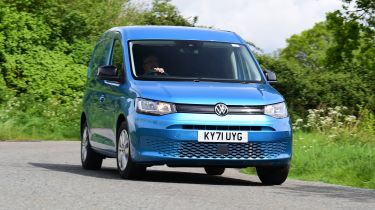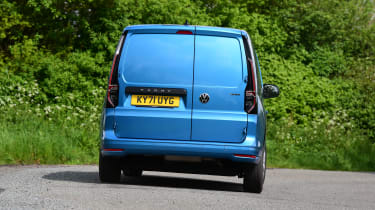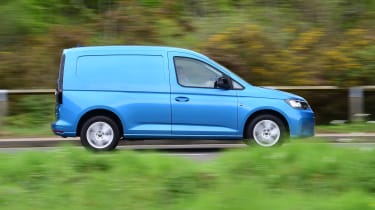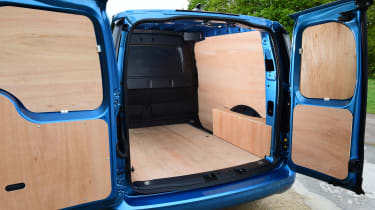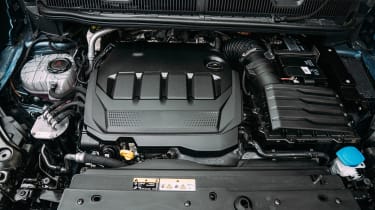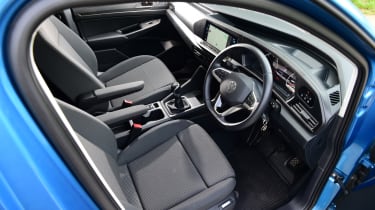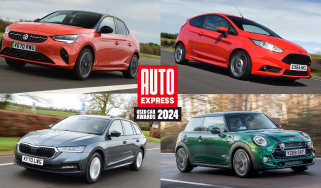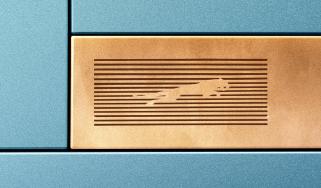Volkswagen Caddy Cargo van review
Golf underpinnings mean the Caddy is one of the most comfortable small vans around
Few small vans are as car-like to drive as the Volkswagen Caddy Cargo. That’s because it uses the same platform as the latest Golf, so it has some solid engineering to build upon. However, this driving ability doesn’t come at the expense of practicality, and the Caddy Cargo is just as capable as its rivals when it comes to carrying capacity.
The exterior has a typically clean VW appearance, and the slender grille and mesh air intakes in the lower bumper share cues with the likes of the Golf and some of VW’s electric models – this is especially noticeable on high-spec cars with colour-coded bumpers. At the back is another distinctive styling touch, with a rear end like an aerodynamic Kamm tail, featuring concave light clusters with LED bulbs.
Inside, there’s more carry-over from the Golf. The multifunction steering wheel is the same, as are the touch-sensitive headlight controls. Unfortunately, the current Golf’s touchscreen and touch-sensitive climate and volume controls are also retained, and these can be quite frustrating to use.
The Caddy Cargo comes in two body lengths, standard (called SWB) and Maxi, with the latter featuring a longer wheelbase and rear overhang to create more space. Both versions feature 60:40 split opening rear doors and a single sliding side door that opens to the kerb. Twin sliding side doors are available as an option, as is a top-hinged rear tailgate.
More reviews
There’s a solitary petrol engine option in the Caddy Cargo, a 1.5-litre TSI four-cylinder turbocharged petrol unit. This is the same powerplant as found in the Golf and numerous other VW Group models, and it’s tuned to produce 112bhp here. It’s front-wheel drive only, while lower-spec versions feature a six-speed manual gearbox and the higher grade models come with a seven-speed twin-clutch DSG automatic. The 1.5 TSI is available in both SWB and Maxi body styles.
For diesel power, VW has changed tack from previous generations by ditching the smaller 1.6 TDI altogether in favour of a 2.0 TDI unit that comes in three power outputs. There are 74bhp, 101bhp and 120bhp versions, with the least powerful only offered in the most basic trim. All variants come with a six-speed manual gearbox, while the seven-speed DSG auto is available in higher-spec trims with the 120bhp diesel. VW has also offered the option of 4MOTION four-wheel drive on and off in the Caddy Cargo, which is a bit of a rarity in the small van market.
Rivals for the VW Caddy Cargo are plentiful in the small van class. The Citroen Berlingo is a perennial favourite, and it’s a very strong option, with different van lengths available, a five-seat crew version and payloads that can go up to one tonne. The Berlingo is joined by a number of virtually identical models from a variety of manufacturers that offer similar abilities and differ only in looks, price and minor specification changes. These include the Peugeot Partner, Vauxhall Combo, Toyota Proace City and Fiat Doblo.
In a similar vein, the Renault Kangoo and Nissan Townstar also share tech between them, while the Mercedes Citan is based on the same engineering, but with a bit of Mercedes star quality added – at a price.
The current Ford Transit Connect is looking a little dated when compared with some rivals. It’s still a good van, but it's due for replacement, which will happen later in 2023 when the all-new model arrives. When it does, it will have a sense of familiarity about it, because it’s based on the Caddy bodyshell. In addition, the Ford Transit Courier is also about to receive an all-new variant in 2024.
If you don’t need to carry a heavy payload, then the estate-based Toyota Corolla Commercial offers an even more car-like drive than the Caddy Cargo, while commercial SUVs are another alternative, with models such as the Suzuki Jimny Commercial and Land Rover Defender Hard Top on offer at different price levels.
One key element that’s lacking from the VW Caddy line-up is an electric powertrain. If you need electrification from a VW van, then the only option currently available is the Volkswagen ID. Buzz Cargo. It’s bigger and pricier than the Caddy Cargo, but it only offers slightly more space over the long-wheelbase Caddy.
MPG, CO2 and Running Costs
The Volkswagen Caddy Cargo has always been a slightly pricier option in the small van class. This is seen as justified by the prestige of the VW badge on the nose, and is usually backed up by stronger residual values for VW’s vans when compared with rivals.
There’s no electric model for super-low running costs, but the petrol and diesel options are pretty economical. VW quotes economy figures in the mid to low-40s for the 1.5 TSI models, while the 2.0 TDI diesels have figures knocking on the door of 60mpg.
What you achieve in the real world will be entirely dependent on the kind of driving you do. While stop-start is fitted as standard, you’re not going to match those economy figures around town, and only smoother driving on country roads and at the national speed limit will get you close.
However, that’s not a criticism of the Caddy Cargo, because the same applies to any other petrol or diesel-powered option. And besides, the 1.5 TSI offers a better balance of performance and economy than most small petrol vans. Choosing an automatic gearbox won’t have too severe an impact on fuel economy, since VW’s DSG twin-clutch auto is a pretty efficient transmission.
All versions of the Caddy Cargo come with a 50-litre fuel tank, which isn’t quite as large as the 54-litre tank you get in a Renault Kangoo, for example, but means that you should get a range of around 480 miles from the petrol models, or up to 650 miles from a TDI diesel variant. Expect a minor penalty with a DSG auto-equipped version.
Load Space and Practicality
While VW offers SWB and Maxi versions of the Caddy Cargo, there’s no crew van variant, and all models have the same roof height. That means the line-up isn’t as comprehensive as some rivals – high roofs are a rarity in the small van class, but most of the Caddy Cargo’s rivals come in crew guise.
The standard Caddy Cargo has 3.1 cubic metres of space inside, but this is slightly less than you’ll find in the likes of the Renault Kangoo and Citroen Berlingo. There’s no through-loading bulkhead, either, so there are no options to expand the cargo space at all.
The cargo area is 1,797mm long, while the maximum width is 1,614mm. The distance between the wheelarches is 1,230mm, but it’s also the same measurement further forward, because there’s a step on either side for the sliding doors. The cargo area measures 1,272mm high, which is taller than a Kangoo, while the rear doors offer an opening of 1,234mm x 1,130mm – change this for a top-hinged tailgate, and the height is slightly lower, at 1,122mm. The sliding side door is a little on the narrow side, measuring 703mm wide and 1,096mm tall.
The Caddy Maxi has a longer wheelbase and an extended rear overhang when compared with the standard van, but a cargo volume of 3.7 cubic metres is half a cubic metre behind that of a LWB Renault Kangoo – it’s the same as a Citroen Berlingo, though. The Caddy Maxi’s cargo floor measures 2,150mm long and the same width as the standard Caddy Cargo. Maximum height inside is 1,275mm, while slightly longer side doors measure 846mm long and the same 1,096mm height.
At the back, the standard Caddy Cargo has a load lip that’s 586mm tall, while the Maxi is slightly higher, at 589mm. This is lower than a Renault Kangoo’s, so might be a bonus if you’re carrying heavy loads. There are six lashing eyes on the load floor to help tie items down.
Payload weights will vary according to specification, but they range from 711-606kg for the 1.5 TSI petrol model, 687kg for the 2.0 TDI 75PS, 677-638kg for the 2.0 TDI 102PS, and 702-636kg for the 122PS version of the 2.0 TDI. Adding a DSG gearbox will reduce the payload weights slightly, but 4MOTION actually increases them. Either way, the Caddy Cargo is a little behind the class leaders, with the Renault Kangoo able to carry almost one tonne of payload in certain guises.
Reliability and Safety
Sharing a platform and electronics with the VW Golf means that the Caddy Cargo benefits from some of the newest safety features that VW has to offer. As a result, it's quite well represented for safety kit, with only a few bits on the options list.
As standard, all models feature ABS with Brake Assist and post-collision braking, driver and passenger airbags (a passenger bag isn’t always offered as standard with rivals), plus side and curtain airbags. There’s Front Assist that automatically applies the brakes if it detects an obstruction ahead, including pedestrians, a driver tiredness monitor, electronic brakeforce distribution, lane assist and cruise control.
The only real safety options are the addition of a central airbag between driver and passenger, and keyless entry and start.
As already mentioned, since the Caddy Cargo shares its running gear with the VW Golf, there’s plenty of familiarity with the cabin. The touch-sensitive controls in places are frustrating, but since they are used on a number of other models as well as the Golf, that means they should work consistently.
The VW Caddy Cargo has a fairly ordinary three-year/100,000-mile warranty, while VW’s Comprehensive or Major Component cover offer warranty extensions to suit different budgets. These can be paid for outright or in instalments.
Driving and Performance
If you enjoy driving, then the VW Caddy Cargo is one of the more engaging small vans, courtesy of those Golf underpinnings. The chassis is nimble, and all versions of the Caddy Cargo feature an electronic differential lock that helps with traction out of corners – it’s not quite the same as the XDS electronic diff that’s fitted to sportier versions of the Golf, but it boosts the van’s agility all the same.
Manual gearboxes have the familiar solid feel of other VW models, and all Caddy vans come with a six-speed transmission as standard. This makes the most of the torque on offer from the petrol and diesel engines, so you will never feel as if you’re in the wrong gear.
The 2.0 TDI 122PS engine is also available with a seven-speed DSG twin-clutch gearbox. This helps take the strain out of driving, and is one of the better automatic gearboxes available. It shifts smoothly, and doesn’t suffer from the hesitation that blights some other transmissions.
The diesel Caddy Cargo is a decent performer whichever version you choose, thanks to its 2.0-litre capacity. Acceleration is smooth, although the lower-powered models do run out of steam quite quickly. Refinement is acceptable, although this is one area where the Golf will always take a lead over the van, while the fitting of a plastic bulkhead instead of a metal one means more noise is transmitted from the cargo area into the cab.
As with any van, the rear suspension is designed with payloads in mind, so there’s a bit of bounce when unladen, but it’s no worse than any rival. One bonus is that the Caddy Cargo can be fitted with ergoComfort seats. These have been certified by German authorities to promote healthy backs, and mean the Caddy Cargo is a top choice for long-distance driving.
The steering is positive, with good responses, while rearward visibility is decent, courtesy of the large door mirrors. Rear parking sensors are standard on all models, as is an electronic parking brake, while top-spec versions also have front parking sensors. VW also offers reversing cameras and blind-spot detection as options to help your awareness of your surroundings.
Cab and Interior
Hard plastics are used throughout the cab, but that’s not such a bad thing for a vehicle that is designed with work in mind. The layout is decent, and those plastics aren’t as brittle as those found in some rivals, with a soft feel for the dash top especially.
There’s fabric upholstery and rubber flooring, but one concession to comfort is that the multifunction steering wheel from the Golf is fitted as standard. There’s a dot-matrix trip computer display between the dials – again sourced from the Golf – while the top-spec Commerce Pro adds digital dials from the Golf, too.
There’s lots of storage inside. The top of the dashboard is designed with a full-width tray across it, while a decent-sized glovebox is fitted, too. There are deep door bins, but an overhead shelf costs extra. Unlike some rivals, there’s no three-seat option in the Caddy Cargo, but VW does offer an optional folding passenger seat back so it can be used as a table.
Standard equipment on the Caddy Cargo in Commerce spec includes a hard plastic bulkhead, fabric seat upholstery, cruise control with speed limiter, electrically adjustable door mirrors, electric windows, LED interior lighting, a multifunction steering wheel, steel wheels with plastic trims and a puncture repair kit (a spare wheel is available as an option)
Infotainment includes a small 6.5-inch touchscreen system with DAB radio, Bluetooth and two USB-C sockets, but only two speakers, while there’s a dot-matrix multifunction display and trip computer between the dials.
Safety kit includes ABS, an immobiliser alarm, cruise control, twin front airbags, eCall emergency system, tyre pressure monitor and a puncture repair kit.
Move to Commerce Plus trim, and extra kit includes body-coloured bumpers, rear parking sensors, air-conditioning, a driver’s seat armrest, leather trim for the multifunction steering wheel, electric lumbar support for the driver’s seat and ergoComfort padding and wired smartphone connectivity.
At the top of the range, the Commerce Pro adds luxuries such as alloy wheels, front and rear parking sensors and a reversing camera, gloss black housings for the heated and electrically adjustable door mirrors, body-coloured door handles and a heated windscreen. There are also LED tail-lights, twin armrests for both front seats and heating, heated screenwash nozzles, keyless entry and starting, a 10-inch touchscreen with sat-nav, four speakers and wireless smartphone connectivity, plus VW’s digital dials.
Van dimensions
| Body style | Height | Width | Length |
| L1H1 standard van | 1,856mm | 1,855mm | 4,500mm |
| L2H1 Maxi van | 1,860mm | 1,855mm | 4,853mm |
(Width including door mirrors: 2,159mm)
Load area dimensions
| Body style | Height | Width | Length | Volume |
| L1H1 standard van | 1,272mm | 1,614mm | 1,797mm | 3.1m3 |
| L2H1 Maxi van | 1,275mm | 1,614mm | 2,150mm | 3.7m3 |

